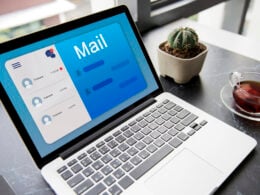Landing your emails in Gmail and Yahoo inboxes is about to get more difficult. In a partnership aimed at fighting spam and spoofing, Google and Yahoo are enforcing new sending guidelines going into effect Feb. 1, 2024.
The update is causing concern among companies sending marketing emails. But with the tips below, you’ll handle it successfully and continue to get your campaigns in the inbox.
Landing your emails in Gmail and Yahoo inboxes: the rules
Gmail and Yahoo are among the most popular email service providers worldwide. Chances are, if your business does email marketing, you have many Gmail and Yahoo contacts on your email list.
To reach these inboxes, you must abide by the following guidelines starting February 1.
Authenticate your emails
Email authentication seems to be Google and Yahoo’s biggest concern. Using a set of specific standards, email authentication verifies the source of an email to ensure it’s legitimate.
“Many bulk senders don’t appropriately secure and configure their systems, allowing attackers to easily hide in their midst. To help fix that, we’ve focused on a crucial aspect of email security: the validation that a sender is who they claim to be,” says Neil Kumaran, Google’s Group Product Manager for Gmail Security and Trust.
So, what does email authentication entail? Here are the three standards that Google and Yahoo recommend. Although not new, these authentication methods are now a must if you want your emails to reach Gmail and Yahoo inboxes.
- Sender Policy Framework (SPF) lets you specify the mail servers authorized to send email from your domain. Thus, receiving servers can identify malicious emails that appear to come from your company.
- DomainKeys Identified Mail Standard (DKIM) prevents spam senders to fake your domain and send email on your behalf. DKIM lets you add a unique signature to your emails to confirm that an email was indeed sent by you and not an impersonator. “When you set up DKIM within your domain provider’s DNS settings, you’re adding another way to tell your receivers: ‘yes, it’s really me who’s sending this message,” Google explains.
- Domain-based Message Authentication, Reporting and Conformance (DMARC) aligns your SPF and DKIM policies and tells receiving servers how to handle the emails you send that do not pass SPF and DKIM checks. This prevents spoofers from faking your domain and sending spam on your behalf.
Setting up SPF, DKIM, and DMARC can be intimidating if you have no experience with email authentication. However, ignoring email authentication isn’t an option—Gmail and Yahoo will mark your messages as spam. So consider using the standards above to secure your domain and protect it from spoofing attacks.
Enable one-click unsubscribes
Wouldn’t you love getting off an email list in just one click? Well, that update is coming soon, too. Google and Yahoo are forcing mass senders to enable one-click unsubscribes, allowing people to opt out of marketing emails more easily. Your email service provider should support this feature—just reach out to your account manager to confirm everything is set up properly.
Additionally, Google and Yahoo are enforcing another unsubscribe rule. Starting February 1, you’ll have to remove unsubscribes within two days, so make sure all the people who opt out stop receiving your emails. Not only is this a rule now, it also helps you avoid spam complaints and continue to land in Google and Yahoo inboxes.
Keep your spam complaint rate under 0.1%
When people report your emails as spam, they tell Google, Yahoo, and other email providers that your messages are bothersome. It’s a red flag that raises the question: why should your emails be in the inbox? So it’s no surprise that a high spam complaint rate will send your campaigns to the junk folder.
But what is a high spam complaint rate? Anything above 0.1%, or one complaint for every 1,000 emails, is reason to worry, Google and Yahoo state. The two providers’ goal is to make email safe and enjoyable for their users, so not allowing annoying emails in the inbox makes sense.
Look at your most recent spam complaint rates. If they exceed 0.1%, it pays to find the cause. Maybe you’re sending too many emails, or perhaps your content isn’t exactly what your audience was expecting from you. Also, reconsider the style of your subject lines—for instance, are you using too many emojis or spammy words?
Scrutinize everything, as every detail matters.
Win $1,000 in Dell Rewards: The Winter Blast Giveaway!
Bonus tips to help your emails go to the inbox
Google and Yahoo’s update may be top of mind for your email marketing team right now. Following the guidelines above will certainly boost your email campaign performance. However, email deliverability, which means reaching the inbox, entails more than this.
Here are a few extra tips to help you reach your audience:
- Keep a close eye on your bounce rate. When more than 2% of your emails bounce, your future campaigns may go to the spam folder. To avoid bounces, remember to validate your email database quarterly.
- Avoid taking long breaks. Stick to a sending schedule to keep your company a familiar presence in people’s inboxes. Sending emails regularly fosters healthy engagement rates, which also helps your email deliverability.
- Send your best content. Many companies aren’t aware of the key role content plays in reaching the inbox. But your content is what makes people either open or ignore your emails. To build trust with your audience, strive to send useful emails that inform, educate, or entertain. You get points if you manage to check all three boxes.
Quick recap
To prepare for the Google and Yahoo update, make sure to authenticate your emails, enable one-click unsubscribes, honor unsubscribes within two days, and keep your spam complaint rate low. Additionally, verify your list and show up for your audience consistently with great emails. That’s how you build trust with email providers and with your subscribers.






